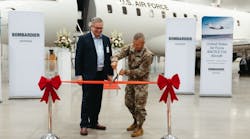By John McHale
SCOTTSDALE, Ariz. - Engineers at General Dynamics C4 Systems in Scottsdale, Ariz., are using software-defined-radio (SDR) technology on board various U.S. Navy surface ships and submarines, as well as fixed land sites, to replace several legacy radios with one system.
General Dynamics’ Wireless Information Transfer System (WITS) technology led to the development of the U.S. Navy’s Digital Modular Radio set. Approximately 750 software-defined channels capable of 2 MHz to 2 GHz operation have been delivered.
The system replaces 14 racks of legacy radios with one easy-to-use system; on certain platforms it can reduce equipment space requirements by more than 50 percent.
Digital Modular Radio is deployed on three Navy attack submarines, two aircraft carriers, five destroyers, and one amphibious transport dock. The first deployment was in 2004 aboard the guided missile destroyer USS Chung-Hoon.
The system is controlled, either locally or across the network, by a user-friendly Windows-based human-machine interface. The Digital Modular Radio system integrates RF communications from 2 MHz to 2 GHz, security, peripheral control, ancillaries, computing, and networking into one system. This open architecture technology helps the Navy switch to its IT21 FORCEnet vision of Network Centric Warfare.
Prior to Digital Modular Radio a separate system was necessary for each waveform and tactical radio systems such as DAMA, HaveQuick, and SINCGARS, as well as data-link coverage for Link-4A and Link 11, says Chris Brady, vice president of assured communications systems for General Dynamics C4 Systems. The SDR capability enables on-site or remote programming via a dedicated LAN or WAN that is controlled from a Windows NT laptop.
Programmable RF channels require no hardware slices or hardware changes and no special modules are necessary for certain functions.
The equipment was mostly commercial-off-the shelf (COTS) for the digital systems, however RF system still require certain MIL-STD requirements that do not lend themselves to COTS solutions, Brady says.
General Dynamics engineers are looking to be more open with the RF requirements and offering the application program interfaces to the government, Brady says.
The digital technology uses 6U PowerPC-based CompactPCI single-board computers. The use of field-programmable gate arrays and the increased functionality they provide are another enabling technology for the Digital Modular Radio solution, company officials say. The boards are mix of proprietary and third-party solutions.
The Digital Modular Radio also has National Security Agency (NSA) certification for software release 6.3.1 for its AN/USC-61 Digital Modular Radio (Digital Modular Radio) system, and contains embedded cryptographic algorithms to provide communications security. The certification enables the Digital Modular Radio system to provide Department of Defense Type I security up to Top Secret/Sensitive Compartmented Information.
The General Dynamics solution also enables users to redefine the operational characteristics of each channel as necessary by changing communications needs and stores a minimum of 12 Digital Modular Radio-developed waveforms. Some store as many as 20 waveforms, Brady says.
The Navy is committed to migrating Digital Modular Radio to Software Communication Architecture (SCA) compliance to enable the use of JTRS JPO-provided waveforms to meet near-term requirements, Brady says.
The solution results in improved training, maintenance, inventory, installation, development and field upgrade costs, General Dynamics officials say.




